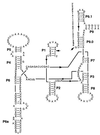Complex evolutionary patterns of tRNA Leu(UAA) group I introns in the cyanobacterial radiation [corrected]
- PMID: 10348857
- PMCID: PMC93812
- DOI: 10.1128/JB.181.11.3445-3451.1999
Complex evolutionary patterns of tRNA Leu(UAA) group I introns in the cyanobacterial radiation [corrected]
Erratum in
- J Bacteriol 2000 Mar;182(5):1457
Abstract
Based on the findings that plastids and cyanobacteria have similar group I introns inserted into tRNAUAALeu genes, these introns have been suggested to be immobile and of ancient origin. In contrast, recent evidence suggests lateral transfer of cyanobacterial group I introns located in tRNAUAALeu genes. In light of these new findings, we have readdressed the evolution and lateral transfer of tRNAUAALeu group I introns in cyanobacteral radiation. We determined the presence of introns in 38 different strains, representing the major cyanobacterial lineages, and characterized the introns in 22 of the strains. Notably, two of these strains have two tRNAUAALeu genes, with each of these genes interrupted by introns, while three of the strains have both interrupted and uninterrupted genes. Two evolutionary distinct clusters of tRNA genes, with the genes interrupted by introns belonging to two distinct intron clusters, were identified. We also compared 16S rDNA and intron evolution for both closely and distantly related strains. The distribution of the introns in the clustered groups, as defined from 16S rDNA analysis, indicates relatively recent gain and/or loss of the introns in some of these lineages. The comparative analysis also suggests differences in the phylogenetic trees for 16S rDNA and the tRNAUAALeu group I introns. Taken together, our results show that the evolution of the intron is considerably more complex than previous studies found to be the case. We discuss, based on our results, evolutionary models involving lateral intron transfer and models involving differential loss of the intron.
Figures






Similar articles
-
Cyanobacterial tRNA(Leu)(UAA) group I introns have polyphyletic origin.FEMS Microbiol Lett. 1997 Nov 15;156(2):293-8. doi: 10.1016/s0378-1097(97)00446-1. FEMS Microbiol Lett. 1997. PMID: 9513279
-
Origin and evolution of group I introns in cyanobacterial tRNA genes.J Bacteriol. 1997 Nov;179(21):6798-806. doi: 10.1128/jb.179.21.6798-6806.1997. J Bacteriol. 1997. PMID: 9352932 Free PMC article.
-
The cyanobacterial origin and vertical transmission of the plastid tRNA(Leu) group-I intron.Curr Genet. 2000 Jan;37(1):12-23. doi: 10.1007/s002940050002. Curr Genet. 2000. PMID: 10672439
-
Analysis of evolution of exon-intron structure of eukaryotic genes.Brief Bioinform. 2005 Jun;6(2):118-34. doi: 10.1093/bib/6.2.118. Brief Bioinform. 2005. PMID: 15975222 Review.
-
Horizontal gene transfer in cyanobacterial signature genes.Methods Mol Biol. 2009;532:339-66. doi: 10.1007/978-1-60327-853-9_20. Methods Mol Biol. 2009. PMID: 19271195 Review.
Cited by
-
The essential gene set of a photosynthetic organism.Proc Natl Acad Sci U S A. 2015 Dec 1;112(48):E6634-43. doi: 10.1073/pnas.1519220112. Epub 2015 Oct 27. Proc Natl Acad Sci U S A. 2015. PMID: 26508635 Free PMC article.
-
Novel group I intron in the tRNA(Leu)(UAA) gene of a gamma-proteobacterium isolated from a deep subsurface environment.J Bacteriol. 2002 Mar;184(5):1481-7. doi: 10.1128/JB.184.5.1481-1487.2002. J Bacteriol. 2002. PMID: 11844784 Free PMC article.
-
Phylogeny and self-splicing ability of the plastid tRNA-Leu group I Intron.J Mol Evol. 2003 Dec;57(6):710-20. doi: 10.1007/s00239-003-2533-3. J Mol Evol. 2003. PMID: 14745540
-
Nested evolution of a tRNA(Leu)(UAA) group I intron by both horizontal intron transfer and recombination of the entire tRNA locus.J Bacteriol. 2002 Feb;184(3):666-71. doi: 10.1128/JB.184.3.666-671.2002. J Bacteriol. 2002. PMID: 11790735 Free PMC article.
-
Lichen fungi have low cyanobiont selectivity in maritime Antarctica.New Phytol. 2003 Oct;160(1):177-183. doi: 10.1046/j.1469-8137.2003.00859.x. New Phytol. 2003. PMID: 33873530
References
-
- Bult C J, et al. Complete genome sequence of the methanogenic archaeon, Methanococcus jannaschii. Science. 1996;273:1058–1073. - PubMed
-
- Burke J M. Molecular genetics of group I introns: RNA structure and protein factors required for splicing. Gene. 1988;73:273–294. - PubMed
-
- Castenholz R W, Waterbury J B. Group I cyanobacteria. In: Staley J T, Bryant M P, Pfenning N, Holt J G, editors. Bergey’s manual of systematic bacteriology. Vol. 3. Baltimore, Md: The Williams & Wilkins Co.; 1989. pp. 1710–1728.
-
- Cech T R, Damberger S H, Gutell R R. Representation of the secondary structure of group I introns. Nat Struct Biol. 1994;1:273–280. - PubMed
Publication types
MeSH terms
Substances
LinkOut - more resources
Full Text Sources

